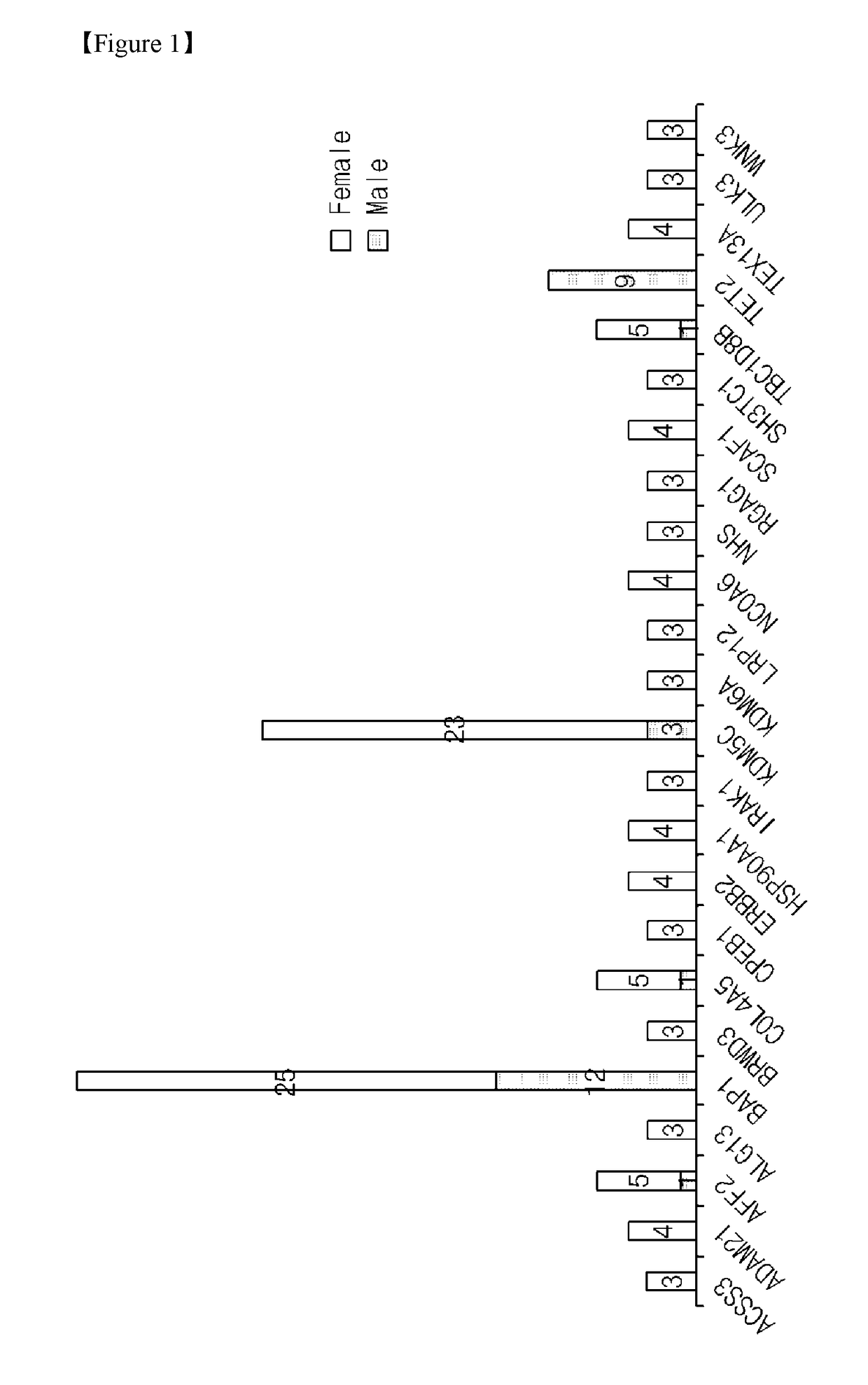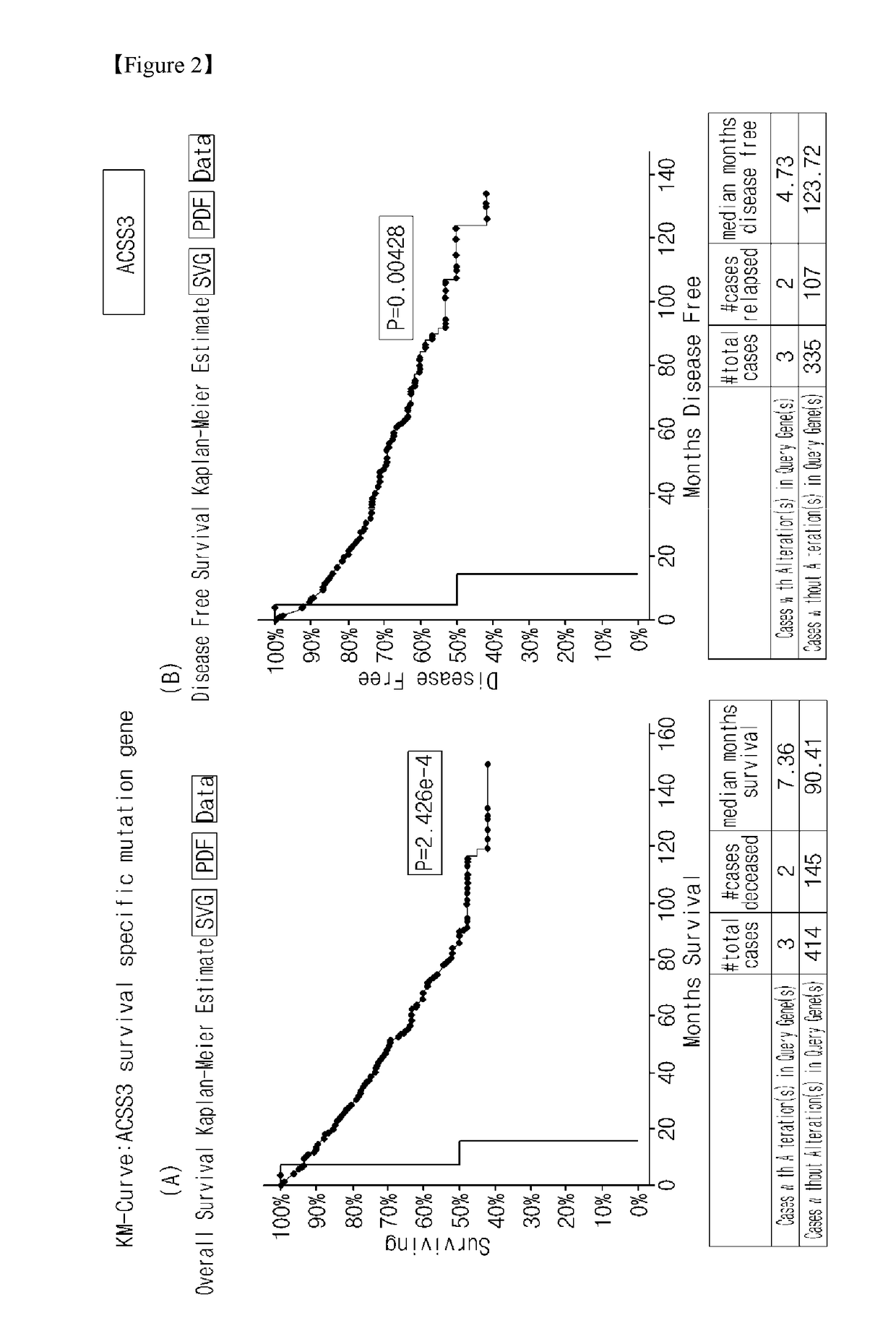Gender-specific markers for diagnosing prognosis and determining treatment strategy for renal cancer patients
- Summary
- Abstract
- Description
- Claims
- Application Information
AI Technical Summary
Benefits of technology
Problems solved by technology
Method used
Image
Examples
example 1
Acquisition of Genetic Information and Clinical Information
[0057]To check whether the genes of (ACSS3, ADAM21, AFF2, ALG13, BAP1, BRWD3, COL4A5, CPEB1, ERBB2, HSP9OAA1, IRAK1, KDM5C, KDM6A, LRP12, NCOA6, NHS, RGAG1, SCAF1, SH3TC1, TBC1D8B, TET2, TEX13A, ULK3, WNK3, ARSF, CFP, FAM47A, PHF16, ZNF449, and SCRN1) may be used as a kidney cancer marker according to the gender of a patient with kidney cancer, the data on the relapse, metastasis, death, and observation time of 417 patients with clear cell renal cell carcinoma whose genetic information and clinical information were all secured were obtained from The Cancer Genome Atlas (TCGA), and used for analyses. The following Table 1 lists the data on the relapse, metastasis, and death of the patients with clear cell renal cell carcinoma.
TABLE 1TotalNumberGenderofRatioMaleFemalepatients(%)Relapse0148 (54.6%) 81 (55.5%)22955.2%177 (28.4%)32 (21.9%)10926.1%Not46 (17.0%)33 (22.6%)7918.7%detectedMetastasis0224 (82.7%) 127 (87.0%) 35184.2%147...
example 2
Confirmation of Usability as Gender-Specific Marker
[0058]417 patients were divided into two groups based on the gender thereof to check a correlation between of the gender and the mutations of the candidate genes in Example 1 using three feature selection methods (Information Gain, Chi-Square, and MR). Mutation positions of the genes are listed in the following Tables 2 to 6.
TABLE 2AccessionAACopyMutationStart EndGeneNo.changeType#COSMICAssessorChrPosPosRefVarACSS3NM_024560.3R634*NonsenseDiploid4chr12 81647354 81647354CTX152_spliceSpliceGainchr12 81503485 81503485TCG268DMissenseGain1Lowchr12 81536908 81536908GAADAM21NM_003813.3N265YMissenseShallowDel2Mediumchr14 70925009 70925009ATR408CMissenseDiploid3Mediumchr14 70925438 70925438CTT589SMissenseDiploid1Lowchr14 70925981 70925981ATI161VMissenseDiploid3Lowchr14 70924697 70924697AGAFF2NM_002025.3S770FMissenseDeepDel1Lowchr23148037884148037884CTP513HMissenseDiploid1Mediumchr23148035250148035250CAT640NMissenseGain1Lowchr23148037494148037...
example 3
Confirmation of Applicability as Survival-Specific Markers According to Gender
[0063]It was confirmed whether there were survival-specific mutant genes among the candidate genes according to the gender. The analyses were performed in the same manner as in Example 2. Mutation positions of the respective genes are listed in Table 12.
TABLE 12AccessionAACopyMutationStart EndGeneNo.changeType#COSMICAssessorChrPosPosRefVarACSS3NM_024560.3R634*NonsenseDiploid4chr12 81647354 81647354CTX152 _spliceSpliceGainchr12 81503485 81503485TCG268DMissenseGain1Lowchr12 81536908 81536908GAALG13NM_001099922.2P925TMissenseDiploidLowchr23110987973110987973CAL195Pfs*23FS delDiploidchr23110951455110951455T—V456EMissenseDiploidMediumchr23110964871110964871TAARSFNM_001201538.1I42FMissenseDiploid1Mediumchr23 2990179 2990179ATCFPNM_001145252.1S27LMissenseDiploid2Mediumchr23 47489070 47489070GAR359QMissenseDiploid1Lowchr23 47485783 47485783CTE135KMissenseDiploid1Lowchr23 47487501 47487501CTE323Gfs*34FS insGain1chr...
PUM
| Property | Measurement | Unit |
|---|---|---|
| Volume | aaaaa | aaaaa |
| Volume | aaaaa | aaaaa |
| Volume | aaaaa | aaaaa |
Abstract
Description
Claims
Application Information
 Login to View More
Login to View More - R&D
- Intellectual Property
- Life Sciences
- Materials
- Tech Scout
- Unparalleled Data Quality
- Higher Quality Content
- 60% Fewer Hallucinations
Browse by: Latest US Patents, China's latest patents, Technical Efficacy Thesaurus, Application Domain, Technology Topic, Popular Technical Reports.
© 2025 PatSnap. All rights reserved.Legal|Privacy policy|Modern Slavery Act Transparency Statement|Sitemap|About US| Contact US: help@patsnap.com



